
Fixed-gear bicycle
Encyclopedia
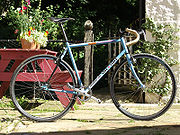
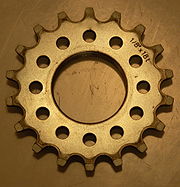
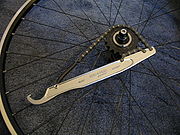
- In Australia, "fixed-wheel" is the normal term for the subject of this article — meaning the opposite of freewheelFreewheelthumb|Freewheel mechanismIn mechanical or automotive engineering, a freewheel or overrunning clutch is a device in a transmission that disengages the driveshaft from the driven shaft when the driven shaft rotates faster than the driveshaft...
, and "fixed-gear" usually refers to a single-speed bicycleSingle-speed bicycleA single-speed bicycle is a type of bicycle with a single gear ratio. These bicycles are without derailleur gears, hub gearing or other methods for varying the gear ratio of the bicycle....
.
A fixed-gear bicycle (or fixed-wheel bicycle, sometimes known as a fixie) is a bicycle
Bicycle
A bicycle, also known as a bike, pushbike or cycle, is a human-powered, pedal-driven, single-track vehicle, having two wheels attached to a frame, one behind the other. A person who rides a bicycle is called a cyclist, or bicyclist....
that has no freewheel
Freewheel
thumb|Freewheel mechanismIn mechanical or automotive engineering, a freewheel or overrunning clutch is a device in a transmission that disengages the driveshaft from the driven shaft when the driven shaft rotates faster than the driveshaft...
, meaning it cannot coast, as the pedals are always in motion when the bicycle is moving.
The sprocket
Sprocket
A sprocket or sprocket-wheel is a profiled wheel with teeth, cogs, or even sprockets that mesh with a chain, track or other perforated or indented material. The name 'sprocket' applies generally to any wheel upon which are radial projections that engage a chain passing over it...
, or cog, is threaded or bolted directly to a fixed rear hub. When the rear wheel turns, the pedals turn in the same direction. This allows a cyclist to stop without using a brake
Bicycle brake systems
A bicycle brake is used to slow down or stop a bicycle. There have been various types of brake used throughout history, and several are still in use today...
, by resisting the rotation of the cranks, and also to ride in reverse.
Uses
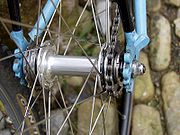
Track bicycle
A track bicycle or track bike is a bicycle optimized for racing at a velodrome or outdoor track. Unlike road bicycles, the track bike is a fixed-gear bicycle and so has a single gear and neither freewheel nor brakes. Tires are narrow and inflated to high pressure to reduce rolling resistance...
is a form of fixed-gear bicycle used for track cycling
Track cycling
Track cycling is a bicycle racing sport usually held on specially built banked tracks or velodromes using track bicycles....
in a velodrome
Velodrome
A velodrome is an arena for track cycling. Modern velodromes feature steeply banked oval tracks, consisting of two 180-degree circular bends connected by two straights...
. But since a "fixed-gear bicycle" is just a bicycle without a freewheel, a fixed-gear bicycle can be almost any type of bicycle.
Some road racing
Road racing
Road racing is a general term for most forms of motor racing held on paved, purpose-built race tracks , as opposed to oval tracks and off-road racing...
and club cyclists used a fixed-gear bicycle for training during the winter months, generally using a relatively low gear ratio, believed to help develop a good pedalling style. In the UK until the 1950s it was common for riders to use fixed-gear bicycles for time trials. The 1959 British 25 mile time trial championship was won by Alf Engers
Alf Engers
Alfred 'Alf' Robert Engers was an English racing cyclist who set national records and won national individual time trial championships from 1959 to the late 1970s. He established a British record of 49 minutes and 24 seconds in 1978, averaging 30.364 mph...
with a competition record of 55 minutes 11 seconds, riding an 84 inch fixed-gear bicycle. The fixed-gear was also commonly used, and continues to be used in the end of season hill climb
Hillclimbing (cycling)
A hill climb is a cycling event, as well as a basic skill of the sport. As events a hill climb may either be an individual time trial or a regular road race. A hill climb usually represents an event which gains altitude continuously, usually terminating at a summit. Well known hill climbs...
races in the autumn. A typical club men's fixed-gear machine would have been a "road/path" or "road/track" cycle. In the era when most riders only had one cycle, the same bike when stripped down and fitted with racing wheels was used for road time trials and track racing, and when fitted with mudguards (fenders) and a bag, it was used for club runs, touring and winter training. By the 1960s, multi-gear derailleur
Derailleur gears
Derailleur gears are a variable-ratio transmission system commonly used on bicycles, consisting of a chain, multiple sprockets of different sizes, and a mechanism to move the chain from one sprocket to another...
s had become the norm and riding fixed-gear on the road declined over the next few decades. Recent years have seen renewed interest and increased popularity of fixed-gear cycling.
In urban
Urban area
An urban area is characterized by higher population density and vast human features in comparison to areas surrounding it. Urban areas may be cities, towns or conurbations, but the term is not commonly extended to rural settlements such as villages and hamlets.Urban areas are created and further...
North America
North America
North America is a continent wholly within the Northern Hemisphere and almost wholly within the Western Hemisphere. It is also considered a northern subcontinent of the Americas...
fixed-gear bicycles have achieved tremendous popularity, with the rise of discernible regional aesthetic preferences for finish and design details.
Dedicated fixed-gear road bicycles are being produced in greater numbers by established bicycle manufacturers. They are generally low in price and characterized by relaxed road geometry, as opposed to the steep geometry of track bicycles.
Fixed-gear bicycles are also used in cycle ball
Cycle ball
Cycle ball, also known as "radball" , is a sport similar to football played on bicycles. The two people on each team ride a fixed gear bicycle with no brakes or freewheel. The ball is controlled by the bike and the head, except when defending the goal.The sport was introduced in 1893 by a...
, bike polo and artistic cycling
Artistic cycling
Artistic cycling is a form of competitive indoor cycling in which athletes perform tricks for points on specialized, fixed-gear bikes in a format similar to ballet or gymnastics...
.
A fixed-gear bicycle is particularly well suited for track stand
Track stand
The track stand is a technique that bicycle riders can use to maintain balanced while their bicycle remains stationary or moves only minimal distances. The technique originated in track cycling and is now used by other types of cyclists wishing to stop for a short time without putting a foot on the...
s, a manoeuvre in which the bicycle can be held stationary, balanced upright with the rider's feet on the pedals.
Advantages and disadvantages
One of the perceived main attractions of a fixed gear bicycle is low weight. Without the added parts required for a fully geared drive train, a fixed gear bicycle weighs significantly less than its geared equivalent. Also, a fixed gear drivetrain is more mechanically efficient than any other bicycle drivetrain, with the most direct power transfer from rider to the wheels. Thus, a fixed gear requires less energy in any given gear to move than a geared bike in the same gear.In slippery conditions some riders prefer to ride fixed because they believe the transmission provides increased feedback on back tire grip.
Descending any significant gradient is more difficult as the rider must spin the cranks at high speed (sometimes at 170 rpm or more), or use the brakes to slow down. Some consider that the enforced fast spin when descending increases suppleness or flexibility, which is said to improve pedalling performance on any type of bicycle; however the performance boost is negligible compared to the benefits of riding a free wheel.
Riding fixed is considered by some to encourage a more effective pedaling style, which is claimed translates into greater efficiency and power when used on a bicycle fitted with a freewheel.
When first riding a fixed gear, a cyclist used to a freewheel
Freewheel
thumb|Freewheel mechanismIn mechanical or automotive engineering, a freewheel or overrunning clutch is a device in a transmission that disengages the driveshaft from the driven shaft when the driven shaft rotates faster than the driveshaft...
may try to freewheel, or coast, particularly when approaching corners or obstacles. Since coasting is not possible this can lead to a 'kick' to the trailing leg, and even to loss of control of the bicycle.
Riding at high speed around corners can be difficult for the novice rider, as the pedals can strike the road, resulting in possible loss of control.
Brakeless
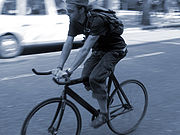
Brakes and their cables are said to add extra bulk to the simple appearance of a fixed gear bicycle.
Other riders dismiss riding on roads without brakes as an affectation, based on image rather than practicality. Riding brakeless can be dangerous, is prohibited by law in many jurisdictions, and may jeopardize the chances of a successful claim in the event of an accident.
Technique
It is possible to slow down or stop a fixed-gear bike by resisting the turning cranks, and a rider can also lock the rear wheel and skid to slow down or stop on a fixed-gear bicycle. Such a move is initiated by unweighting the rear wheel while in motion by shifting the rider's weight slightly forward and pulling up on the pedals using clipless pedals or toe clips and straps. The rider then stops turning the cranks, thus stopping the drivetrain and rear wheel, while applying body weight in opposition to the rotation of the cranks. This causes the rear wheel to skid, and slow the bike. The skid can be held until the bicycle stops or until the rider desires to continue pedalling again at a slower speed. The technique requires a little practice and using it while cornering is generally considered dangerous. A wet surface further reduces the effectiveness of this method.On any bike with only rear wheel braking, the maximum deceleration is significantly lower than on a bike equipped with a front brake. As a vehicle brakes, weight is transferred towards the front wheel and away from the rear wheel, decreasing the amount of grip the rear wheel has. Transferring the rider's weight back increases rear wheel braking efficiency, but a front wheel fitted with an ordinary brake might provide 70% or more of the braking power when braking hard (see Weight transfer
Weight transfer
Weight transfer and load transfer are two expressions used somewhat confusingly to describe two distinct effects: the change in load borne by different wheels of even perfectly rigid vehicles during acceleration, and the change in center of mass location relative to the wheels because of...
).
Legality
United States — The use of any bike without brakes on public roads is illegal in many places, but the wording is often similar to "...must be equipped with a brake that will enable the person operating the cycle to make the braked wheels skid on dry, level and clean pavement..." which some have argued allows the use of the legs and gears. The retail sale of bikes without brakes is banned by the U.S. Consumer Product Safety CommissionConsumer Product Safety Commission
The United States Consumer Product Safety Commission is an independent agency of the United States government created in 1972 through the Consumer Product Safety Act to protect "against unreasonable risks of injuries associated with consumer products." The CPSC is an independent agency that does...
– but with an exception for the "track bicycle" (...a bicycle designed and intended for sale as a competitive machine having tubular tires, single crank-to-wheel ratio, and no free-wheeling feature between the rear wheel and the crank....).
UK — The Pedal Cycles Construction and Use Regulations 1983 require pedal cycles "with a saddle height over 635 mm to have two independent braking systems, with one acting on the front wheel(s) and one on the rear". It is commonly thought that a front brake and a fixed rear wheel satisfies this requirement .
Germany — All bicycles are required to have working brakes on both wheels, as well as reflectors and bells. In Bonn
Bonn
Bonn is the 19th largest city in Germany. Located in the Cologne/Bonn Region, about 25 kilometres south of Cologne on the river Rhine in the State of North Rhine-Westphalia, it was the capital of West Germany from 1949 to 1990 and the official seat of government of united Germany from 1990 to 1999....
a local court accepted that the fixed-gear mechanism was suitable back brake, but high-profile crackdowns specifically targeted fixies in Berlin, in an attempt to control what police described as a "dangerous trend"
Australia — In every state, bicycles are regarded as vehicles under the Road Rules. By law, a bike is required to have at least one functioning brake.
New Zealand — By law all bicycles must have a minimum of "...a good rear brake..."—and those made since 1 January 1988 must also have "...a good front brake..."
France — To be approved for road traffic, a bike must have 2 brakes, 2 lights, numerous reflectors, and a ringer. However the laws are rarely enforced, and the sight of all kinds of non officially approved bikes is quite common.
Denmark — All bicycles are required to have working brakes on both wheels, as well as reflectors and bells.
Conversion
Many companies sell bicycle frameBicycle frame
A bicycle frame is the main component of a bicycle, on to which wheels and other components are fitted. The modern and most common frame design for an upright bicycle is based on the safety bicycle, and consists of two triangles, a main triangle and a paired rear triangle...
s designed specifically for use with fixed-gear hubs. A fixed-gear or track-bike hub includes special threads for a lockring that tightens in the opposite (counter-clockwise) direction compared with the cog. This ensures that the cog cannot unscrew when the rider "backpedals" while braking.
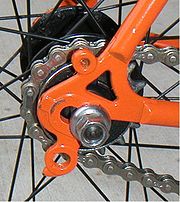
Dropout (bicycle part)
A bicycle dropout is a type of fork end that allows the rear wheel to be removed without first derailing the chain. The more inclusive term fork end refers to a slot in a frame or fork where the axle of the wheel is attached....
s are straightforward to convert, frames with vertical dropouts less so. One method is to simply replace the rear wheel with a wheel that has a track/fixed hub. Another is to use a hub designed for use with a threaded multi-speed freewheel. Such a hub only has the normal right-handed threads for the cog and not the reverse threads for the lockrings used on track/fixed hubs. The sprocket on a hub without a lockring may unscrew while back pedalling. Even if a bottom bracket lockring is threaded onto the hub, along with a track sprocket, because the bottom-bracket lockring is not reverse threaded, the possibility still exists that both the sprocket and locknut can unscrew. Therefore it is recommended to have both front and rear brakes on a fixed-gear bicycle using a converted freewheel hub in case the cog unscrews while back pedaling. It is also advisable to use a thread sealer
Thread-locking fluid
Thread-locking fluid is a thin, single-component adhesive, applied to the threads of fasteners such as screws and bolts to prevent loosening, leakage, and corrosion. Typically, thread-locking fluids are methacrylate-based, and cure anaerobically...
for the cog and bottom bracket lockring. The rotafix
Rotafix
The Rotafix is a method of tightening or loosening a sprocket on a track bike or fixed gear bicycle.- Method :The Rotafix enables the securing of a sprocket to a track hub without the use of a chain whip....
(or "frame whipping") method may be helpful to securely install the sprocket.
Bicycles with vertical dropouts and no derailleur require some way to adjust chain tension. Most bicycles with horizontal dropouts can be tensioned by moving the wheel forward or backward in the dropouts. Bicycles with vertical dropouts can also be converted with some additional hardware. Possibilities include:
- An eccentricEccentric (mechanism)In mechanical engineering, an eccentric is a circular disk solidly fixed to a rotating axle with its centre offset from that of the axle ....
hub or bottom bracketBottom bracketThe bottom bracket on a bicycle connects the crankset to the bicycle and allows the crankset to rotate freely. It contains a spindle that the crankset attaches to, and the bearings that allow the spindle and cranks to rotate. The chainrings and pedals attach to the cranks...
allows the off center axleAxleAn axle is a central shaft for a rotating wheel or gear. On wheeled vehicles, the axle may be fixed to the wheels, rotating with them, or fixed to its surroundings, with the wheels rotating around the axle. In the former case, bearings or bushings are provided at the mounting points where the axle...
or bottom bracket spindle to pivot and change the chain tension. - A Ghost or floating chainring is an additional chainring in the drive train between the driving chainring and sprocket. The top of the chain moves it forward at the same speed that the bottom of the chain moves it backwards, giving the appearance that it is floating in the chain.
- A magic gear—the right math can calculate a gearing ratio to fit a taut chain between the rear dropout and bottom bracket. Also, using a chain half link and slightly filing the dropouts to increase the width of the slot increases the chances of finding a magic gear. It is worth noting that the magic gear setup is controversial, due to inevitable chain stretch and subsequent slippage that can lead to serious injury.
Separate chain tensioning devices, such as the type that attaches to the dropout gear hanger (commonly used on single speed mountain bikes) cannot be used because they are damaged as soon as the lower part of the chain becomes tight.
Additional adjustments or modification may be needed to ensure a good chainline. The chain should run straight from the chainring to the sprocket, therefore both must be the same distance away from the bicycle's centerline. Matched groupsets of track components are normally designed to give a chainline of 42 mm, but conversions using road or mountain bike cranksets often use more chainline. Some hubs, such as White Industries' ENO, or the British Goldtec track hub, are better suited to this task as they have a chainline greater than standard. Failure to achieve good chainline, at best, leads to a noisy chain and increased wear, and at worst can throw the chain off the sprocket. This can result in rear wheel lockup and a wrecked frame if the chain falls between the rear sprocket and the spokes. Chainline can be adjusted in a number of ways, which may be used in combination with each other:
- Obtaining a bottom bracket with a different spindleSpindle (tool)In machine tools, a spindle is a rotating axis of the machine, which often has a shaft at its heart. The shaft itself is called a spindle, but also, in shop-floor practice, the word often is used metonymically to refer to the entire rotary unit, including not only the shaft itself, but its bearings...
length, to move the chainring inboard or outboard - Choosing a bottom bracket with two lockrings, which gives fine adjustment of chainring position
- Respacing and redishing the rear wheel, where permitted by the hub design
- Placing thin spacers under the bottom bracket's right-hand cup (Sturmey-Archer make a suitable 1/16" spacer) to move the chainring outboard
- Placing thin spacers between the chainring and its stack bolts to move it inboard (if the chainring is on the inside of the crank spider) or outboard (if the ring is on the outside of the spider)
- Placing thin spacers between the hub shoulder and the cog- only recommended in the case of a freewheel-threaded hub, which has sufficiently deep threads for this
Competition
There are many forms of competition using a fixed gear bike, most of the competitions being track races. Bike messengersBicycle messenger
Bicycle messengers are people who work for courier companies carrying and delivering items by bicycle. Bicycle messengers are most often found in the central business districts of metropolitan areas...
and other urban riders may ride fixed gear bicycles in alleycat races
Alleycat races
An Alley Cat race is an informal bicycle race. Alley Cats almost always take place in cities, and are often organized by bicycle messengers. The informality of the organization is matched by the emphasis on taking part, rather than simple competition...
, including New York City's famous fixed-gear-only race Monstertrack alleycat
Monstertrack alleycat
Monstertrack is an alleycat race started by a New York City bike messenger, "Snake", in the year 2000. It is a race specifically for brakeless, fixed-gear bicycles. It has gradually grown in size because of the surging popularity of track bikes. Carlos "Diablo" and Victor "Freeway" work as bike...
.
There are also events based on messenger racing, such as Mixpression, which has been held nine times in Tokyo. Trick demonstrations have been held since the late 1800s in the US and Europe; while they continued into a competitive form in Europe (Artistic Cycling
Artistic cycling
Artistic cycling is a form of competitive indoor cycling in which athletes perform tricks for points on specialized, fixed-gear bikes in a format similar to ballet or gymnastics...
), subsequent to the recent widespread popularity and advancement of fixed gear bikes, trick competitions have also now established themselves at venues in the US and Asia. European competitions include solo and team balletic movements on a controlled, flat surface; US and Asian competitions often include "park" and "flatland" styles and venues, a la BMX. Other competitions include games of "foot down" and bike polo.
In 2006, Adventures for the Cure
Adventures for the Cure
Adventures For The Cure is a non-profit organization and USA Cycling club that exists to raise awareness for diabetes and other selected charities...
made a documentary film on riding across the United States on fixed gears; they repeated this feat as a 4-man team at the 2008 Race Across America
Race Across America
The Race Across America, or RAAM, is an ultra marathon bicycle race across the United States that started in 1982 as the Great American Bike Race....
.
Fixed gear riders sharing the specific philosophy are also seen at the Single Speed World Championship
Single Speed World Championship
The Single Speed World Championship, or SSWC, is an annual event. It is only open to bicycles with a single gear ratio. Those bicycles can be either singlespeeds or fixed-gears...
s.
Maintenance and upkeep
Maintaining a fixed gear is relatively easy because it has fewer parts than a geared bicycle. The sprocket should be checked regularly to make sure there is no damage to any teeth and that no object is grinding it as it turns with the rear wheel. The chainring should be checked similarly for any damage.It is imperative (for road riding, at least) that the chain is sufficiently tight that it is impossible for it to derail from either the chainring or sprocket. This generally equates to "no visible slack". A derailed chain can cause a variety of undesirable consequences, such as a locked rear wheel or, worst of all, destruction of the frame if the chain becomes caught around the crank arm and pulls the rear triangle forwards. On a fixed-gear bicycle without hand brakes, even a relatively benign derailment means a total loss of braking ability. Tensioning aside, a chain is significantly less likely to derail if the chainline is accurate and the chain is a traditional "full bushing" type with limited lateral flexibility. Because the difference between a tight and a slack chain equates to only very minor elongation of the links, chain tension should be visually checked at least weekly, especially if the bicycle is ridden in wet or dirty conditions.
As with any other bicycle, the chain should be checked making sure the master link is securely latched. The chain can be lubricated monthly for smooth riding. Also, as needed, the brakes should be tightened as they wear and tire condition observed for possible puncture locations. Air pressure in the tires, tire alignment, brake handle placement, and rust should be monitored on a daily basis because they can change very easily during a jarring ride.
Community
The fixed-gear movement is spreading over the globe, and is growing in Sweden. A cornerstone of the Swedish fixed-gear society is the Internet based forum Fixedgear.se, with over 2300 registered members. This makes up for the main meeting ground and discussion forum for Swedish fixed-gear riders and enthusiasts.There are also several bicycle clubs throughout Sweden with a fixed-gear niche. Komet Club Rouler is a club based in Gothenburg, annually arranging Svart Katt and other fixed-gear oriented activities. Svart Katt has been internationally recognized and is considered Sweden’s largest alley cat by number of participators, according to Cog Magazine. KCR’s equivalent in Malmö is called Pista Malmø, arranging ”Thursday's rides” every Thursday, for all bikes and riders.
Popularity factors
Several factors contribute to the recent rise in popularity of fixed-gear bicycle. A rider from Stockholm interviewed for an article about the phenomenon notes that riding a bike imparts a feeling of freedom to the rider. You are free to go wherever you want, whenever you want. A sense of belonging is also important; as the rider says, “everybody that bikes are my friends”. Riders unknown to each other commonly greet each other when on bikes. As in many subcultures, this feeling of belonging is a key factor in recruiting and retaining participants.The fact that many fixie riders ride brakeless in defiance of local law could also be viewed as a contributing factor to its popularity; it provides an outlet for minor rebellion.

